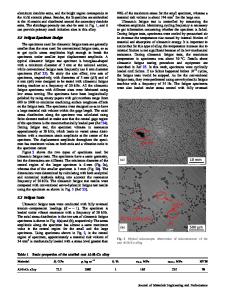Low-cycle fatigue crack initiation and break in strain-life curve of Al-Li 8090 alloy
- PDF / 1,424,477 Bytes
- 4 Pages / 612 x 792 pts (letter) Page_size
- 69 Downloads / 472 Views
Low-Cycle Fatigue Crack Initiation and Break in Strain-Life Curve of Al-Li 8090 Alloy YONG JUN OH, BONG SANG LEE, SANG CHUL KWON, JUN HWA HONG, and SOO WOO NAM The Al-Li alloys have intrinsically low ductility because the shearable d' (Al3Li) induces severe strain localization in spite of their benefits of high modulus and low density.[1,2] Under the low-cycle fatigue condition, the presence of shearable d' is known to alter the deformation mode from inhomogeneous at low stain amplitude to homogeneous at high stain amplitude,[3–6] which results in a change in the cyclic stress-strain responses. Some investigators[7] have suggested that the transition in deformation mode is closely related with the change in the slope of the plastic strain– fatigue life curve, named the Coffin–Manson curve, which has been generally observed in the precipitate-hardened alloys. However, the explicit mechanism to correlate the deformation mode with the change in the slope has not been clarified yet. In the present work, the mechanistic explanation to rationalize the change in the slope of the Coffin– Manson curve was provided for Al-Li 8090 alloy by investigating the fatigue crack initiation processes and the
YONG JUN OH, BONG SANG LEE, and SANG CHUL KWON, Senior Researchers, and JUN HWA HONG, Project Manager, are with Nuclear Materials Technology Development Team, Korea Atomic Energy Research Institute, Taejon 305-600, Korea. SOO WOO NAM, Professor, is with Department of Materials Science and Engineering, Korea Advanced Institute of Science and Technology, Taejon 305-701, Korea. Manuscript submitted August 3, 1998.
METALLURGICAL AND MATERIALS TRANSACTIONS A
Fig. 1—Cyclic stress amplitude vs plastic strain amplitude for the peakaged and solutionized conditions of Al-Li 8090 alloy.
related microstructures under the peak-aged and solutionized (or naturally aged) conditions. The Al-Li alloy investigated in this study was supplied by Alcan International Ltd. (Montreal, Canada) as extruded flat bars (300 3 30 mm2) in the solution-heat-treated condition. It had a chemical composition of 2.60Li, 1.40Cu, 1.0Mg, 0.11Zr, and balance Al in weight percent. The asreceived alloy was solution treated at 525 7C for 30 minutes, water quenched, and aged at 190 7C for 12 hours to achieve the peak-aged condition. In this condition, the spherical d' precipitates were homogeneously distributed in the interior of the grain, resulting in a precipitate-free zone (PFZ) near the grain boundary. Furthermore, the presence of magnesium led to the precipitation of needlelike Al2CuMg (S') phase. At the peak-aged condition, the alloy exhibited tensile strength of 515 MPa, yield strength of 480 MPa, and elongation of 8 pct. The low-cycle fatigue tests were conducted at an ambient temperature for both the peak-aged and solutionized samples. The specimens had smooth, cylindrical gage sections 7-mm long and 5 mm in diameter. The surfaces of the specimens were mechanically polished up to 0.25 mm alumina powder to examine the initiated surface crack. The cyclic stress a
Data Loading...











